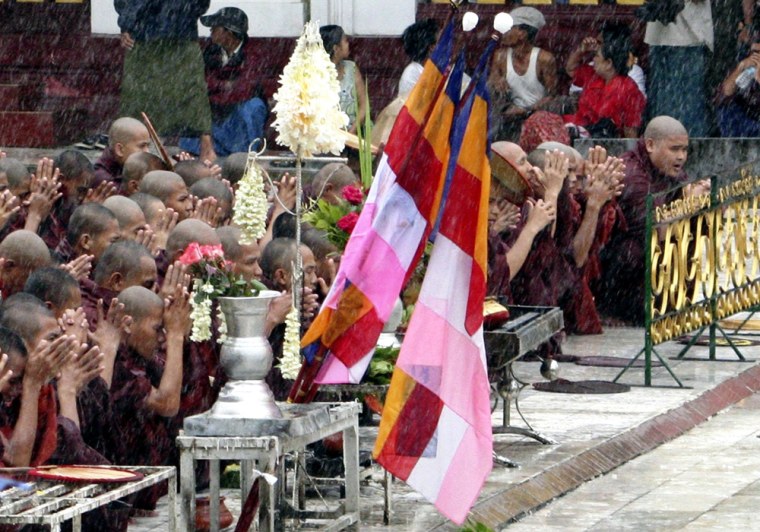Almost 1,000 Buddhist monks marched through the streets of Myanmar's biggest city Thursday, protected by a human chain of onlookers as they kept alive the most sustained and defiant protests against the military government in at least a decade.
Having gathered at the golden hilltop Shwedagon pagoda, the country's most revered shrine, the monks marched to Sule pagoda in downtown Yangon and then rallied briefly outside the U.S. Embassy. Washington is one of the junta's major foreign critics.
With no destination evident, the monks marched through many of Yangon's main thoroughfares, attracting supporters as they carried on. Thousands of people walked alongside or behind them as they marched past Scott's Market, the city's main market that is also a magnet for tourists.
Third straight day
It was the third straight day the monks have marched in Yangon. Their activities have given new life to a protest movement that began a month ago after the government raised fuel prices, sparking demonstrations against policies that are causing economic hardship.
As they marched calmly in long processions though the city streets, onlookers accorded the monks respect by making the traditional Buddhist gesture of hands clasped together in front of bowed heads. They also offered snacks and drinks to the marchers, while others kept the streets clean by picked up water bottles.
Such open expressions of support had been lacking at smaller demonstrations carried out by laymen over the past month.
At the head of the procession were monks carrying religious flags and one carrying a begging bowl upside down, a symbol of protest. About 1,000 mostly young bystanders marched alongside, arms linked, to prevent any intrusion. No uniformed security personnel were in sight, though dozens of plainclothesmen stood by without interfering.
The monks had gathered at the Shwedagon in early afternoon, where they were able to enter the temple to say prayers. As they marched, the monks chanted sermons.
No specific gestures
In the Buddhist fashion of avoiding direct secular entanglements, the monks are making no explicit anti-government gestures, but their message is unmistakable to fellow citizens, because their normal duties outside their monasteries involve making morning rounds with begging bowls, individually or in small groups.
On Wednesday, a large crowd cheered as monks briefly occupied Sule pagoda, during one of several marches around the country. The monks pushed past closed gates to occupy the temple for 30 minutes before returning peacefully to their monasteries, witnesses said.
At least four separate marches by monks took place Wednesday in Yangon, along with protests in at least two other cities, Sittwe and Mandalay.
The saffron-robed monks have become the leaders of a movement launched on Aug. 19, when a few hundred ordinary citizens marched to protest a government increase in fuel prices. Several hundred activists have been detained.
Angry over being beaten at an early demonstration, monks threatened to take to the streets unless the military junta apologized. The regime remained silent so they launched protests around the country Tuesday that have grown from several hundred monks to several thousand.
Refusing alms
Monks also are refusing alms from the military and their families _ embarrassing the junta. Some monks have started a religious boycott of the junta, symbolized by their holding their black begging bowls upside down as they march. In the Myanmar language, the word for boycott comes from the words for holding the bowl upside down.
Monks, who are highly respected in Myanmar and integral to almost all aspects of daily life, have historically been at the forefront of protests _ first against British colonialism and later military dictatorship. They played a prominent part in a failed 1988 pro-democracy uprising that sought an end to military rule, imposed since 1962.
The protests also reflect long pent-up opposition to the repressive military regime, and have become the most sustained challenge to the junta since a wave of student demonstrations that were put down by force in December 1996.
The junta's crackdown on the protesters have drawn increasing criticism from world leaders, including U.N. Secretary-General Ban Ki-moon and U.S. President George W. Bush, who also have called for the government to release opposition leader Aung San Suu Kyi.
Suu Kyi, a Nobel Peace laureate, has been under house arrest for more than 11 of the past 18 years.
The state-run newspaper, the New Light of Myanmar, claimed Wednesday that bogus monks, "instigators" and foreign radio station reports were helping to swell the crowds at protests.
Myanmar monks' demonstrations continue
Almost 1,000 Buddhist monks marched through the streets of Myanmar's biggest city Thursday, protected by a human chain of onlookers as they kept alive the most sustained and defiant protests against the military government in at least a decade.

/ Source: The Associated Press